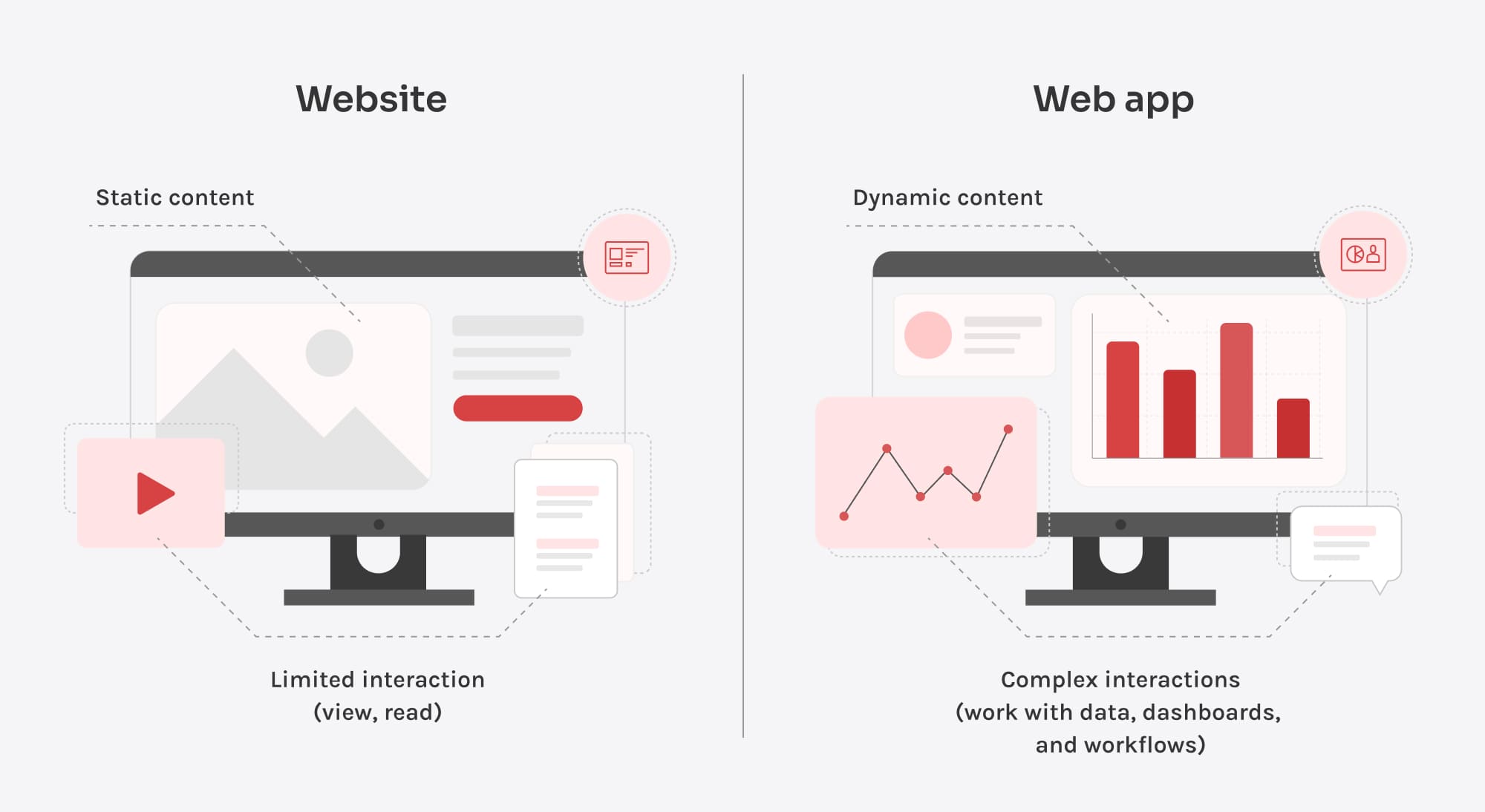Il tuo messaggio è stato inviato.
Elaboreremo la vostra richiesta e vi ricontatteremo al più presto.
Il modulo è stato inviato con successo.
Ulteriori informazioni sono contenute nella vostra casella di posta elettronica.

Selezionare la lingua



Immaginate questo: Siete il proprietario di una piccola impresa e, nel tentativo di incrementare le vendite, lanciate un'applicazione web per migliorare l'esperienza di acquisto da mobile. Ci investite qualche migliaio di euro, ma il traffico è inferiore alle aspettative e i clienti sembrano continuare a utilizzare il vostro sito web ottimizzato per i dispositivi mobili. Cosa è andato storto? Si scopre che i clienti non avevano bisogno di un'applicazione web separata: il sito ottimizzato per i dispositivi mobili rispondeva già perfettamente alle loro esigenze.
Succede (spesso). A volte le aziende investono in un'applicazione web, pensando che sia il modo migliore per migliorare l'esperienza mobile, per poi scoprire che è inutile e costosa.
Questo ci porta alla domanda: cosa è meglio tra un'applicazione web e un sito web? In questo blog analizzeremo alcune differenze chiave, le grandi domande di business che devono trovare risposta e le comuni insidie da evitare quando si prende una decisione. Alla fine, avrete un'idea chiara di cosa sia meglio per voi.
Quando pianificate il vostro prossimo progetto digitale, non pensate al dibattito tra web app e siti web come a una formalità tecnica. Dovrete considerare i vostri obiettivi individuali e il modo in cui intendete svilupparvi nel tempo, compreso il modo in cui la vostra azienda appare online, il modo in cui gli utenti interagiscono con voi e la facilità con cui le operazioni di back-end vengono eseguite.
Ad esempio, un sito web è di fatto il vostro quartier generale digitale, che funge da luogo centrale per l'intera offerta commerciale. Ciò significa che i siti web sono orientati alle aziende che vogliono costruire la consapevolezza del marchio, incrementare la generazione di lead e scalare la classifica SEO.
Le web app, invece, sono perfette per le aziende che desiderano coinvolgere gli utenti, attivare interazioni in tempo reale o supportare i flussi di lavoro interni. Poiché eseguono una logica dinamica sul lato client e server, si integrano direttamente con i sistemi backend e si adattano al comportamento degli utenti al volo. Ciò significa meno passaggi manuali, risposte più rapide e processi senza colli di bottiglia.
Inutile dire che una configurazione digitale sbagliata può limitare l'interesse dei clienti o la domanda del mercato, con conseguente perdita di opportunità commerciali. È quindi meglio riflettere bene su ciò che fa al caso vostro. Analizziamo ulteriormente le differenze tra un'applicazione web e un sito web.
"La scelta tra un sito web e un'applicazione web può influenzare tutto, dall'esperienza dell'utente al ROI. Vi aiutiamo a capire cosa si adatta effettivamente ai vostri obiettivi aziendali, rende felici i vostri utenti e non fa saltare il budget".

Direttore tecnologico
Qual è la differenza tra un sito web e un'applicazione? L'aspetto più rilevante è che negli ultimi anni i confini tra siti web e applicazioni sono diventati sempre più labili.
Che differenze ci sono tra le applicazioni basate sul web e i siti web? Un sito web è un'applicazione? Le risposte non sono così semplici. Tecnicamente, ogni applicazione web è un sito web (poiché vi si accede tramite il web), ma non tutti i siti web sono applicazioni web. Tuttavia, i siti web utilizzano oggi funzionalità che prima erano limitate alle applicazioni, diventando più interattivi che mai.
Ci sono anche portali web personalizzati - in pratica applicazioni web che assomigliano a normali siti web. Se vi permette di accedere, interagire e gestire i vostri dati, siete sicuramente nel territorio delle app.
Avete mai sentito parlare delle progressive web app (PWA)? Si tratta di siti web che si comportano come applicazioni mobili, ma senza la necessità di scaricarle dall'App Store o da Google Play. Ma questa è un'altra storia. Torniamo alla questione web app vs. sito web.
Per i titolari di aziende impegnate, prendere decisioni significa tagliare i ponti con la confusione e concentrarsi su ciò che conta di più. Ecco un rapido confronto dei fattori di maggiore impatto per aiutarvi a definire ciò che è meglio per voi senza impantanarvi in dettagli tecnici.
Siti web sono un punto di contatto cruciale per gli utenti che desiderano navigare contenuto statico - contenuti che possono visualizzare e leggere. Offrono un'esperienza semplice e informativa che sembra utile, non invasiva.
D'altra parte, le web app sono molto più dinamiche con i loro aggiornamenti al minutoe potenti strumenti di acquisto che consentono agli utenti di manipolare i dati, interagire con i dashboard, personalizzare i flussi di lavoro e altro ancora.
La mia prima raccomandazione è questa: invece di vedere costi di sviluppo come un peso, vederli come un investimento strategico.
Quando si valutano la complessità e il costo dello sviluppo di un sito web rispetto a quello di un'applicazione web, la prima opzione sembra essere più facile e conveniente. Un sito web può essere lanciato rapidamente utilizzando soluzioni e modelli già pronti, che riducono i costi di sviluppo e il time to market.
D'altra parte, una web app è un sistema completamente funzionale con interazioni con gli utenti, database, integrazioni con altri servizi e, naturalmente, aggiornamenti regolari per mantenere la sicurezza e la funzionalità. Una soluzione di questo tipo non può essere a basso costo, vista la quantità di funzionalità da implementare. Le applicazioni web richiedono inoltre una manutenzione continua, che si aggiunge alle spese a lungo termine.
I siti web sono facili da gestire: meno aggiornamenti, meno problemi. Le applicazioni web? Una storia diversa. Richiedono una manutenzione periodica: lancio di funzionalità, correzione di bug e modifiche alle prestazioni, ma il livello di personalizzazione e flessibilità che si può ottenere è ineguagliabile.
Quando si parla di sicurezza e conformità, le applicazioni web richiedono innegabilmente misure di sicurezza e conformità più elevate.Esse elaborano e memorizzano i dati degli utenti, spesso si integrano con altri servizi e impiegano complessi meccanismi di autenticazione. Tutto ciò aumenta il rischio di vulnerabilità della sicurezza, il che rende indispensabile la supervisione. I siti web in genere necessitano solo di misure di base come le notifiche dei cookie, rendendo la loro sicurezza più semplice. .
C'è un'altra cosa importante da aggiungere: La sicurezza non è qualcosa che potete permettervi di trascurare. Non è facoltativo. È sempre in cima alle vostre priorità. Considerate che anche un semplice sito web può trasformarsi in un bersaglio se trascurate gli standard di sicurezza fondamentali.
Ho condensato tutti questi punti in una tabella semplice e di facile consultazione.
| Fattore | Sito web | Applicazione web |
| Interattività | Interazione limitata (moduli, navigazione) | Interazioni complesse (dashboard, automazione) |
| Complessità dello sviluppo | Veloce da costruire, utilizzando modelli e funzionalità standard | Richiede uno sviluppo personalizzato e aggiornamenti continui |
| Costo | Costo iniziale più basso | Costo iniziale più elevato, investimento a lungo termine maggiore |
| Manutenzione | Manutenzione ridotta, soprattutto aggiornamenti dei contenuti | Richiede aggiornamenti continui e piani di scalabilità |
Dovete optare per un semplice sito web o investire in un'applicazione web completa? Ogni soluzione presenta vantaggi e svantaggi specifici. Ecco quali sono le prime soluzioni da adottare.
Credo che la chiave per scegliere tra un sito web e un'applicazione web sia la comprensione degli obiettivi aziendali e delle esigenze del pubblico.
Se il vostro obiettivo principale è quello di far conoscere il vostro marchio, condividere contenuti e generare traffico, un sito web è probabilmente ciò di cui avete bisogno. È ottimo per diffondere il vostro messaggio e per entrare in contatto con un vasto pubblico.
Ma se la vostra azienda vuole ottimizzare i processi, offrire automazione o fornire una soluzione SaaS più complessa, un'applicazione web è la strada da percorrere. Come già detto, può offrire maggiore flessibilità, interattività e un'esperienza personalizzata basata su dati in tempo reale, che un normale sito web non è in grado di gestire altrettanto bene. Inoltre, pensate all'esperienza dell'utente: se avete bisogno di un alto livello di interattività e personalizzazione, un'applicazione web sarà molto più adatta a queste esigenze.
Quando si tratta di un progetto, il budget è l'elefante nella stanza. In poche parole, la decisione finale tra web app e sito web dipende in gran parte da considerazioni di carattere finanziario. I costi iniziali più bassi e il ROI più rapido rendono i siti web interessanti per le aziende che vogliono stabilire rapidamente una presenza online senza un enorme investimento iniziale. Le applicazioni web, invece, richiedono un investimento iniziale più elevato, sia in termini di sviluppo che di manutenzione continua. Quindi, se state pianificando una crescita significativa o avete esigenze complesse, un'applicazione web potrebbe valere il costo iniziale più elevato, in quanto i potenziali ritorni possono essere molto maggiori.
Per quanto riguarda il time to market, la scelta dipende molto dalla necessità di essere operativi rapidamente o di pianificare una crescita sostenuta nel tempo. I siti web sono rapidi da lanciare, il che li rende perfetti per le aziende che hanno bisogno di essere operative rapidamente con funzionalità di base. Come si può intuire, per scalare in modo efficace con la crescita dell'azienda possono essere necessari aggiornamenti importanti. Salve, costi aggiuntivi in futuro. Al contrario, le applicazioni web hanno un ciclo di sviluppo più lungo a causa della loro complessità e delle funzionalità personalizzate.
La tabella seguente è stata pensata per aiutarvi a farvi un'idea iniziale di quando avete bisogno di un sito web e di quando la vostra azienda ha bisogno di un'applicazione web.

Quando si progetta un sito web o un'applicazione web, un fatto rimane vero: molto probabilmente avrete bisogno di un team specializzato se volete eseguirlo correttamente. E qui arrivano le insidie.
Cerchiamo di capirlo. Avevate dei dubbi su cosa scegliere: un'applicazione web o un sito web. Avete scelto un partner di sviluppo che vi sembrava adatto, senza vagliare a fondo le sue competenze o il suo lavoro precedente. O forse lo avete scelto solo per il basso costo iniziale.
Hanno avviato il progetto. Il team vi ha aiutato a scegliere senza comprendere i vostri requisiti aziendali. Perché è stato un problema? Vi hanno guidato verso la soluzione sbagliata fin dall'inizio. Potreste ritrovarvi con un'applicazione web quando vi serviva solo un sito web semplificato. Oppure vi siete accontentati di un sito semplice che non è in grado di gestire le funzionalità che i vostri utenti si aspettano.
Una situazione del genere si verifica se al vostro fianco c'è il partner sbagliato. Quindi, cosa fare per evitare questi spiacevoli esiti?
Innanzitutto, è essenziale avere una chiara visione del lavoro che ci aspetta. Le applicazioni Web richiedono sviluppatori esperti con una conoscenza completa del codice pulito, della sicurezza, dell'architettura del database e dell'integrazione delle API. Questi progetti di solito prevedono elaborati flussi di lavoro per gli utenti, gestione dei dati e un framework scalabile, il che significa che la pianificazione e le scorciatoie sono fuori questione.
Anche se in genere meno complessi, i siti web richiedono comunque un approccio strategico. Gli sviluppatori possono occuparsi della costruzione, ma il vero successo dipende da qualcosa di più di una semplice pulizia design del sito web. Senza una solida conoscenza delle migliori pratiche SEO, del design dell'esperienza utente (UX) e dell'ottimizzazione delle prestazioni, anche il sito web più accattivante rischia di essere seppellito nei risultati di ricerca.
Invece di scegliere il team affidabile dei vostri sogni con il cuore o con una sensazione istintiva, lasciate che siano i fatti a guidarvi. Per quanto riguarda i partner di sviluppo, ciò implica progetti reali con risultati reali e affidabili.
Una nota azienda di trasporti europea ha incontrato difficoltà nel controllare una flotta di autisti in continua crescita e un team di assistenza in espansione. Oltre all'aumento della scala operativa, l'ottimizzazione della programmazione degli autisti, dell'elaborazione delle buste paga e delle comunicazioni richiedeva ulteriori strumenti.
L'azienda era alla ricerca di modi per migliorare l'efficienza senza spendere troppo e tenendo conto dell'esperienza dell'utente finale. Era combattuta tra due opzioni: costruire un sito web tradizionale o scegliere una soluzione più dinamica - una web app. L'obiettivo era quello di determinare quale sarebbe stata la soluzione migliore per soddisfare le loro esigenze di monitoraggio in tempo reale, gestione del personale ed efficienza operativa.
Si sono rivolti a Innowise, un fornitore leader di servizi di sviluppo web, e il nostro primo passo è stato quello di effettuare una consulenza per individuare i problemi di fondo dell'azienda. I problemi principali erano:
Dopo aver esaminato queste esigenze, Innowise ha suggerito di sviluppo progressivo di app servizio. Perché? Scoprite cosa offrono le PWA:
I risultati sono stati immediati:
Abbiamo guidato il nostro cliente nella scelta della soluzione più adatta alle sue esigenze e ai suoi obiettivi aziendali. Da Sviluppo di siti web SaaS in outsourcing con il nostro team, il cliente ha ottenuto risultati immediati e una base scalabile per una crescita a lungo termine.
Vale la pena ripeterlo: la scelta di un sito web o di un'applicazione web non è solo una decisione tecnologica, ma è una mossa cruciale che può determinare il successo complessivo della vostra strategia digitale. Se sbagliate, rischiate di prosciugare il vostro budget, di bloccare la crescita e di costruire qualcosa che non corrisponde affatto alle vostre reali esigenze. Ecco dove le cose vanno spesso storte e come evitarle.
Se la vostra azienda ha bisogno di una presenza online principalmente per condividere informazioni, costruire una brand awareness o supportare il content marketing, direi che un sito web è sufficiente. A applicazione web personalizzata è ideale quando avete bisogno di interazioni complesse con gli utenti, di aggiornamenti in tempo reale o di integrazioni avanzate. Ma se non siete ancora a quel punto, iniziare con un'applicazione web significa pagare per funzionalità che non vi servono e assumere un livello di complessità che può rallentare la vostra attività.
Consigli: Scegliete un sito web quando le vostre priorità sono velocità, semplicità e visibilità. In questo modo si ottiene rapidamente una presenza online curata, senza intaccare il budget a disposizione. Poi, quando vedrete una reale richiesta di funzionalità interattive o di automazione, potrete far evolvere il vostro sito in qualcosa di più potente con uno scopo e una tabella di marcia chiari.
Le applicazioni Web gestiscono spesso i login degli utenti, i dati di pagamento o le informazioni aziendali sensibili e sono quindi più suscettibili ai cyberattacchi. Quando i team danno la priorità alle date di lancio e considerano la sicurezza come un'opzione secondaria, mettono a rischio l'esposizione degli utenti ed erodono la fiducia, due elementi che, una volta persi, sono estremamente difficili da ricostruire.
Consigli: Prendete sul serio la sicurezza e la conformità del vostro processo fin dal primo giorno. Utilizzate un'autenticazione sicura, crittografate i dati sensibili, seguite le best practice per il GDPR o altre normative e verificate regolarmente le vulnerabilità. Una base sicura non solo protegge i vostri utenti, ma prima di tutto protegge il vostro marchio.
Una soluzione che funziona bene per 100 utenti potrebbe cedere sotto il peso di 10.000. Questo non vuol dire fare un'eccessiva ingegnerizzazione fin dall'inizio, ma fare scelte ponderate su piattaforme, framework e architetture che possano crescere con voi.
Consigli: Privilegiate un design modulare, un hosting flessibile e piattaforme che supportino componenti aggiuntivi o integrazioni. Scegliete fin dall'inizio strumenti e tecnologie che non vi limitino in futuro.
Molte aziende concentrano tutte le loro energie (e il loro budget) sulla fase di lancio, per poi rendersi conto troppo tardi che la manutenzione richiede attenzione e investimenti costanti. I costi correnti, come le spese per i server, gli aggiornamenti software, le patch di sicurezza, la messa a punto delle prestazioni e i miglioramenti delle funzionalità possono accumularsi silenziosamente.
Consigli: La manutenzione implica l'affinamento dell'esperienza, l'ottimizzazione delle prestazioni e l'aggiunta delle funzionalità che gli utenti desiderano man mano che l'azienda cresce. Accantonate budget e risorse per gli aggiornamenti di routine, il supporto tecnico e i miglioramenti guidati dagli utenti.
Quando si prende la decisione giusta, non solo lo si sente, ma lo si vede. I risultati sono misurabili: tassi di conversione più elevati, numerose recensioni positive e un'attività in crescita. E nessun costoso passo falso! Se non siete sicuri di quale opzione scegliere, siamo qui per aiutarvi con i nostri esperti servizi di consulenza per lo sviluppo web.

Gestore di portafoglio in tecnologie sanitarie e mediche
Dmitry vede il quadro generale dello sviluppo web. Non si occupa solo di prestazioni o di scala (anche se queste sono importanti), ma si concentra sulla costruzione di fondamenta digitali che siano moderne oggi e affidabili domani, indipendentemente dalla velocità di crescita.












Il tuo messaggio è stato inviato.
Elaboreremo la vostra richiesta e vi ricontatteremo al più presto.

Iscrivendosi si accetta il nostro Informativa sulla privacy, compreso l'uso dei cookie e il trasferimento dei vostri dati personali.